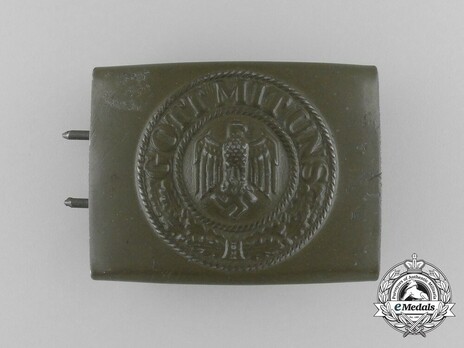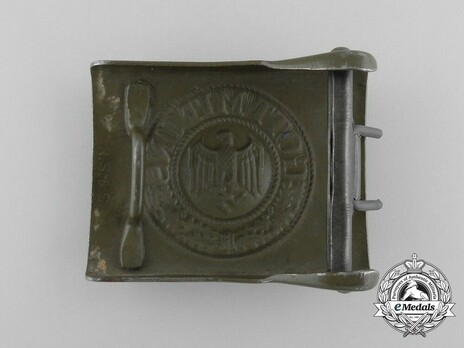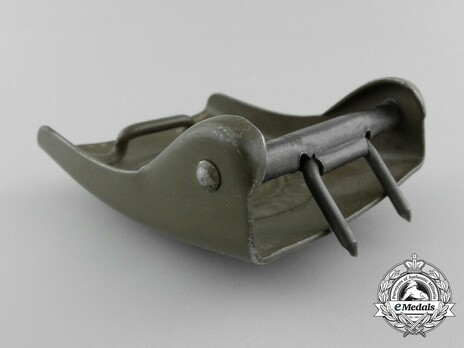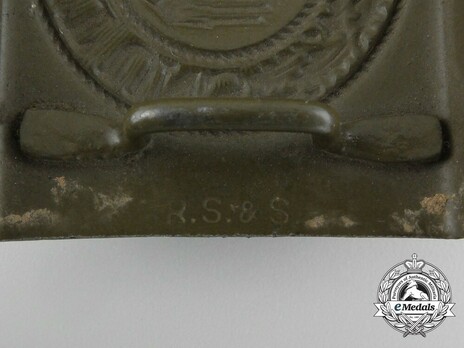Afrikakorps Heer NCO/EM Belt Buckle
CATEGORY: Version
SKU: 23.GOR.02.02.01.002.000
Estimated market value:




Estimated market value:
German Africa Corps EM/NCO’s belt buckle; constructed of pressed steel (magnetic); with very well preserved original olive drab paint; maker marked “RS & S” for “Richard Simm & Söhne” on the reverse; measuring 63 mm x 48 mm; extremely fine condition.
During the Second World War, German troops stationed in northern Africa are generally referred to as the Afrikakorps. Technically, this is not entirely correct, since some German units operating in Africa were not actually part of the DAK (Deutsches Afrikakorps), and some units of it were, in fact, Italian ones. However, for the purpose of collecting so-called “tropical” uniforms and insignia, collectors have simplified the meaning of the term.
The first German troops were sent to northern Africa in February of 1941, to support their Italian allies against the British. The climate of the African continent made it necessary to wear specialised uniforms and gear that not only supported the soldiers in serving in a hot and arid environment, but also helped them in blending in with the landscape, which, in general, presented itself as brown, olive, khaki, or sand/tan in colour. Worn over long periods of time under the blistering desert sun, some uniforms were eventually bleached to white or off-white. Uniforms and insignia in these colours are often referred to as “tropical”, and it is worth noting that they weren’t just worn by members of units stationed in Africa, but in the entire Mediterranean theatre of war, including southern France, Italy, the Balkans, and Greece, as well as in southern Russia during the summer months. Tropical uniforms were worn by members of all three branches of the Wehrmacht: the Heer (army), the Kriegsmarine (navy), and the Luftwaffe (air force). Members of the Waffen-SS stationed in southerly regions also wore tropical-style uniforms, and even though they technically have no connection to the DAK, all tropical uniforms and insignia of all branches of the German military are listed here.
The belt buckle worn by NCOs (non-commissioned officers) and EMs (enlisted men) was introduced in a regulation from January 24, 1936. Initially it was made of nickel or aluminum alloy, and consisted of two pieces. A stamped center disc was attached to the rectangle by four folded tabs. The letters read: Gott mit uns (God with us). Initially buckles had a pebbled field, but later buckles with a smooth field were introduced as well, which eventually became the general pattern.
Later in 1936 a die struck one-piece buckle with either a bright metal finish or an olive green factory paint finish for wear in combat was introduced. In 1940 buckles made of steel were produced, the colour varied between light apple green, olive green, and field grey. Some buckles were painted yellow ochre by soldiers in the field in Italy or North Africa for a better camouflage effect.
The tropical version of the belt buckle was introduced in 1941. The buckle was painted dark olive-green. This version came with a webbing belt instead of a leather one, presumably because leather would not be suitable for the hot and dry conditions. The colour was a light olive yellow, the belt was sand-coloured.
In the beginning the eagle faced to the wearer’s right, which was soon changed to an eagle facing to the wearer’s left. Ultimately it was changed back. The reasons for these changes are unknown.

Comments
Sign in to comment and reply.


Scroll Top